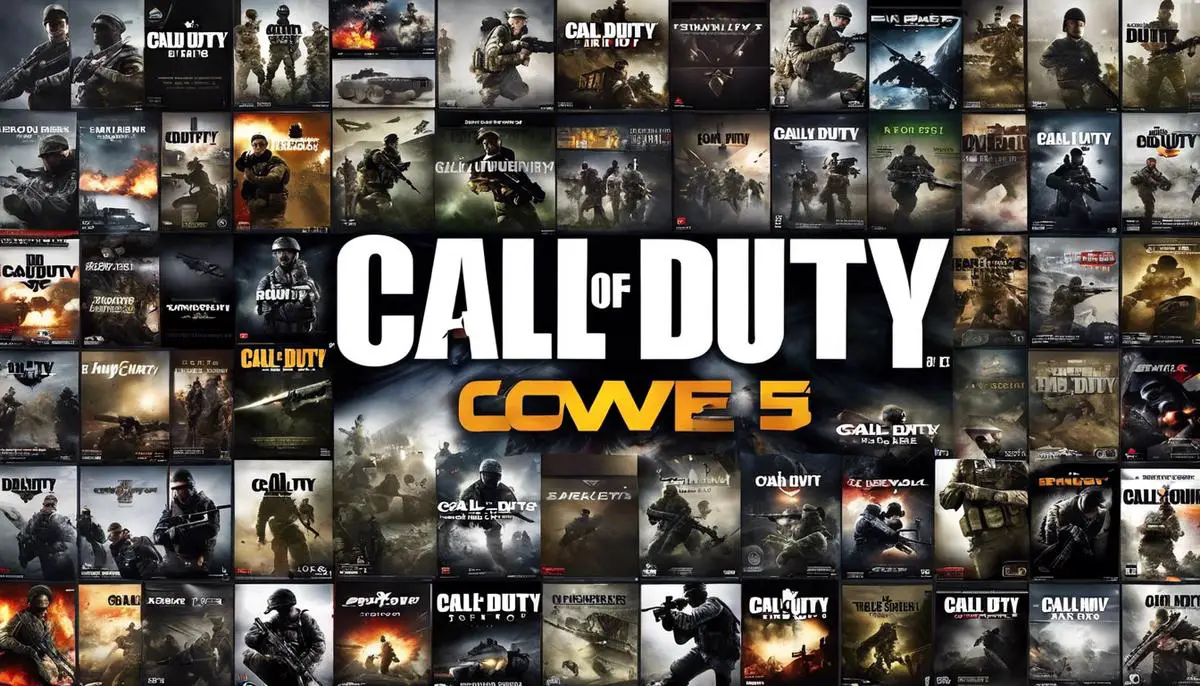Embodying the perfect blend of technology, narrative, and interactive engagement, video games have evolved into a significant medium for storytelling and entertainment, and no other franchise exemplifies this better than Call of Duty. Bursting into the scene in 2003, the series has played a pivotal role in the rise of the gaming industry, evolving both graphically and functionally to meet the industry’s rigorous demands. Tracing the origins back to Infinity Ward’s creation managed by Activision, this discourse navigates the trajectory of Call of Duty, from its initial humble beginnings to its current iconic status. Beyond its technology and gameplay enhancements, the series’ massive cultural impression on the rapidly growing gaming community is explored, touching on e-sports, streaming, and community engagement. Intertwining narrative further inspects the series’ sub-brands like Modern Warfare and Black Ops, illuminating how each has enriched and diversified the overall franchise. Finally, it gazes into the future, pondering the incorporation of emerging tech trends into the Call of Duty universe.
Origins of the Call of Duty Series
The genesis of the popular Call of Duty Series traces back to late 2003, when the world of video gaming got a new hero- a first-person shooter game enthralling audiences with its realistic portrayal of war. But, let’s dial back a bit and understand what led to this phenomenal development.
Computer and video game developer, Infinity Ward, materialized from the focused vision of a group of 22 employees from the defunct studio, 2015, Inc. They were the talented minds behind the successful war-themed game, Medal of Honor: Allied Assault. This passionate team, along with the backing from the publisher, Activision, embarked on the creation of a fresh game series, which later became the globally recognized Call of Duty.
The first installment of Call of Duty, or CoD as it’s famously known, hit the shelves in October 2003. Using the id Tech 3 engine, borrowed from another successful video game, Quake III Arena, CoD became addictive to players due to its immersive gameplay. Unlike its competitors, CoD put players in the shoes of ordinary soldiers, rather than the lone combatant, tapping into the team spirit and camaraderie of actual warfare. This was indeed a turning point, altogether shaping the future of team-oriented, war-based games.
CoD exemplified through its gaming mechanics how individual roles could dramatically impact the teamwork effect in an ongoing mission, which was a new concept at the time. Through this depiction, CoD quickly won the favor of war game enthusiasts, leading to its instant popularity. This grasp of teamwork-in-combat concept and one in three perspectives founded CoD as an industry’s leading first-person shooter game.
CoD’s next chapter, Call of Duty 2, released in 2005, took the game’s popularity to a higher level by showcasing the advanced capabilities of the then new Xbox 360. The game’s detailed graphics, sound, and AI performance displayed an impressive upgrade, taking the gaming experience to new heights of realism. Furthermore, it marked the introduction of multi-player modes, setting a new benchmark in the gaming community.
The third installment, Call of Duty 3, although was developed by a different developer, Treyarch, it continued the triumphant story of CoD. It was the first to exclusively be released on consoles, marking an important transition in the series.
The true revolution came in 2007, with Call of Duty 4: Modern Warfare. From its historical World War II setting, CoD took a bold leap and put players in a contemporary setting. Moreover, it presented a modern twist in combat techniques, gear, and AI. This change was remarkably well-received and revolutionized military-themed games as never before.
Since then, there has been no looking back for the CoD series. It has continued to adapt and evolve with each installment, introducing innovative features, unnerving situations, engaging narrative, and high adrenaline action, keeping the global gaming community spellbound.

Call of Duty’s Technological Evolution
Riding the Tech Wave: The Technological Evolution of Call of Duty
Riding the wave of technological evolution, the Call of Duty series has embraced technology and innovation like no other, forever transforming the landscape of gaming. With each new installment, the series demonstrates a commitment to pushing the boundaries of what is possible in the gaming sphere, continually introducing new aspects that enhance gameplay and usher in unprecedented levels of realism.
Ever since the release of Call of Duty 4: Modern Warfare, the series has been an arena for cutting-edge tech trends and pioneering advances. As a floodgate for radical innovations, Modern Warfare introduced a new layer of reality into gaming that many gamers hadn’t seen before. Through refined graphics and revolutionary game physics, gamers found themselves lost in the lifelike environments, immersed in the cinematic sequences, and gripped by the high-stakes, action-packed scenarios.
In Call of Duty: Black Ops, advancements in game design and programming allowed for more intricate, engaging storylines. The game integrated groundbreaking graphics with advanced artificial intelligence to produce characters and enemies that functioned and reacted with enhanced realism. This innovative use of AI forged a new path for game development, redefining gamers’ expectations of realistic narratives and intelligent gameplay.
With the introduction of Call of Duty: Advanced Warfare, futuristic technology and weaponry became the new standard. The integration of gadgets like exoskeletons, cloaking devices, and drones, were not simply plot devices, but tools to enhance player interaction and strategic decision-making. Add to that the implementation of the forward-thinking physics-based rendering system that significantly ameliorated the visual graphics, creating a more immersive and visually spectacular gaming experience.
The release of Call of Duty: Warzone redefined the battle royale genre. Leveraging the power of cloud technology, Warzone allowed up to 150 players to compete simultaneously in a vast, detailed map. This technological leap made possible the massive scale of player engagement and interactivity that Warzone has become famous for.
Lastly, we can’t review the technological evolution of the Call of Duty series without mentioning Call of Duty: Mobile. With the smartphone revolution, gaming has become a predominantly mobile affair. COD: Mobile has managed to encapsulate the essence of its PC and Console counterparts into a handheld experience, thanks to the advances in smartphone technology, bolstered by more potent processors and superior graphics.
Innovative technology and creativity have been intertwined intricately in the progression of the Call of Duty series. Each new game brought not only a new storyline but also a barrage of tech advancements that reinvigorated the gaming experience. The stalwart commitment to technological innovation has positioned the Call of Duty series at the forefront of gaming breakthroughs. It will be fascinating to see how this beloved series will continue to maneuver the ever-evolving tech landscape to surprise and impress gamers with its future installments.

Sub-brands creation and innovation
The introduction of Call of Duty (CoD) sub-brands such as Modern Warfare, Black Ops, Advanced Warfare, Warzone, and Mobile was a strategic response to a shifting market and the growth of the franchise. These sub-brands were designed to cater to different gaming tastes and technological advancements, while simultaneously keeping the spirit of the original CoD games intact.
The key motive behind the creation of these sub-brands was essentially to diversify. The CoD franchise recognized the need to appeal to diverse gaming styles, technological capacities, and audience preferences, and the sub-brands were seen as a way to achieve this diversity. The creation of CoD: Modern Warfare, for instance, tapped into the modern military trend, while Black Ops brought in elements of Cold War espionage, providing a distinct gaming experience to its users within the CoD framework.
Advanced Warfare used the future as a basis for its game design, introducing high-tech, futuristic weaponry, and high-resolution graphics for a crisper look, keeping up with more recent gaming consoles and their capabilities. Meanwhile, Warzone’s cloud-based technology allowed multiple players to engage with the game from different geographical locations simultaneously, clearly following the rise of online multiplayer games.
Undoubtedly, Mobile was an answer to the increasing popularity of smartphone gaming. Desiring to make their brand more accessible and convenient for gamers who favored mobile over traditional gaming platforms, CoD: Mobile was introduced to bring the console experience to the palm of your hand, significantly increasing the franchise’s user base.
The impacts of these sub-brands’ creation were notable and multi-faceted. The first was the expansion of the user base. By catering to different gaming and platform preferences, CoD managed to attract more players, consequently increasing its brand value and profit margins significantly.
Secondly, it allowed the franchise to stay relevant. A dynamic brand that evolved with changing consumer preferences and technology, CoD managed to avoid fading into obscurity, unlike some other gaming franchises of its time.
Moreover, the sub-brands allowed the franchise to experiment with various themes, designs, and gameplay mechanics. This not only enriched the overall CoD experience but also led to the creation of successful standalone games such as Warzone, which showed that the franchise could go beyond its traditional first-person shooter format.
Finally, with each sub-brand, the CoD franchise reaffirmed its commitment to technological prowess, creativity, and advanced gaming experiences. As a result, the Call of Duty series cemented its place as an innovator in the industry, driving other franchises to step up their game in response.

Call of Duty’s Impact on Gaming Culture and Community
While the success and legacy of the Call of Duty series is undeniable, its influence on gaming culture as a whole bears remarkable significance. This influence has not been limited to shaping the gaming landscape but extends to defining and instilling certain standards in commercial and free-to-play games alike.
One of the most notable impacts of the Call of Duty series is its commitment to storytelling. Following the introduction of cinematic gameplay in Call of Duty 4: Modern Warfare, the gaming industry saw a noticeable shift towards narrative-driven games. This emphasis on intricate plotlines and complex character development has since become a staple in the gaming sphere, creating unforgettable experiences for players.
Moreover, Call of Duty’s multiplayer mode has played a seismic role in shaping online gaming culture. Providing a platform for players to compete in an intensely realistic military setting, the series sparked a trend that paved the way for other franchises such as Battlefield and Halo, which are admired for their online multiplayer offerings.
A primary catalyst in the thriving esports industry, Call of Duty’s competitive multiplayer gaming has drawn in millions of spectators worldwide. The introduction of Call of Duty World League in 2016 added a legitimate professional platform that built a vast community of professional gamers while validating esports as a reputable and profitable venture.
In addition to bolstering the rise of esports, the Call of Duty series propelled the conception and popularity of video game streaming. Call of Duty gameplay videos and live streams quickly became a favorite among viewers, inspiring the advent of platforms such as Twitch and YouTube Gaming that cater specifically to streaming video game content.
The Call of Duty franchise also played a big part in the advent of DLCs (Downloadable Content) in the gaming industry, which is now an integral part of monetization processes for countless game developers. By offering additional content outside of the main game at a price, game creators have found a new way to engage their audiences and hike earnings.
Finally, yet importantly, the Call of Duty series’ influence on the gaming culture is manifested in the shift towards platform inclusivity. The decisive move to intertwine PC, console, and smartphone gaming, particularly with the launch of CoD: Mobile, prompted game developers to make their titles more universally accessible, ultimately fueling the rise of cross-platform gaming.
Thus, the Call of Duty series continues to carve a path for the gaming industry, advocating progress in technological innovation, gameplay design, and community-building alike. Its vast influence undeniably shapes gaming culture today, continually setting new standards and inspiring peers in the industry.

Call of Duty’s Future: Tech Expectations
Looking to the future, we know the path of the Call of Duty series will continue to be shaped by technological advancements. With a strong foundation laid in narrative storytelling, multiplayer modes, and DLCs, the sky’s the limit. Propelled by the notion of platform inclusivity, the series unquestionably has the potential to revolutionize game compatibility.
The advent of virtual reality (VR) and augmented reality (AR) could bring new perspectives to the first-person shooter genre. Imagine being fully immersed in the battleground, running through a war-torn city or feeling the heat of an explosion – not just through a controller, but with your whole being. By merging gameplay with the physical world, creating a surreal, hyper-realistic experience, the potential of VR and AR integration is genuinely thrilling.
Artificial intelligence (AI) has been making strides in several industries, and gaming is no exception. Implementation of AI could mean smarter, more autonomous non-player characters (NPCs). They might even learn from players’ past strategies, adapting to provide a more challenging gameplay experience. Enhanced AI can also lend a hand in controlling in-game environmental aspects, making them more dynamic and responsive to player actions.
With the onset of 5G and subsequent network generations, one can anticipate more significant logistical capacity in multiplayer combat. The ultra-low latency rate of these networks can eradicate lag, providing seamless, instant communication, essential for coordinating strategies in real-time during gameplay.
Considering the consonance of the Call of Duty series with shifting technological trends, it might not be far-fetched to speculate that it might embrace cloud gaming. Rather than being tied to a specific console, cloud gaming could enable players to experience Call of Duty on any device with an internet connection, significantly broadening its player base. Moreover, cloud computing could aid in handling more significant quantities of data, facilitating crowded, dynamic multiplayer battles.
The concept of machine learning, a subset of AI, could provide more personalized gaming experiences. By compiling and analyzing player data, the game could tailor difficulty levels, pace, and variants in game narratives to each player, enhancing engagement and replayability.
In essence, CoD could potentially integrate these advanced technological trends to elevate gameplay experiences to new heights. From seen advancements in AI, VR, AR, machine learning, cloud computing, and network upgrades, it’s clear that the Call of Duty series won’t be ready to hang up its boots anytime soon. We, eager tech enthusiasts, wait with bated breath for what’s next in this technological warfare.

The Call of Duty franchise emerged not simply as another video game series, but as a piece of the cultural fabric defining the 21st century’s digital age. Innovations in technology transformed and nurtured its gameplay and graphics, while the creation of the sub-brands like Modern Warfare and Black Ops ensured the series stayed fresh, engaging, and relevant. The franchise has ascended to a level that it has a defining say in shaping gaming culture and community interaction norms. Peering into the future, the series is anticipated to maintain its trailblazing nature, evolving concurrently with, if not ahead of, the gaming industry’s tech expectations, including AI, graphic design, physics, and multiplayer functionality. Embracing emerging technology trends such as VR and AR will further solidify its position in the gaming industry, affirming that Call of Duty’s influence will continue to reverberate through future generations of gaming technology and culture.
- Guide to Life Is Strange: True Colors Ch. 1 Choices - April 4, 2024
- Catching Spiritomb in Pokemon BDSP - April 4, 2024
- Mastering Life Is Strange: Key Choices in Chapter 1 - April 4, 2024
Visits: 2








